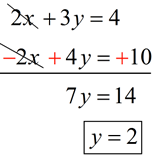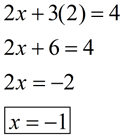Up to this point, our systems of equations have had at least one variable with a coefficient of "one". Now, let's take a look at systems where this limitation no longer holds.
The methods of solution that can be used to solve the systems on this page are the same as those previously seen: "Elimination", "Substitution", and/or "Graphing". We will be concentrating on the "elimination" method, as it requires the most additional algebraic work. Remember: the elimination method creates one set of variables with the same coefficients, so that the variables can be eliminated. We will start with some simple situations and then jump into the more challenging situation.
Solution - Elimination Method: • First, rewrite the equations to line up the matching variables and constants.
Solution - Elimination Method: • Notice that 4 is a multiple of 2 (on the y-variables). This means that only the second equation will need to be multiplied times 2 to create the same coefficients on the y-variables. 
Solution - Elimination Method: • In these systems, we will need to multiply BOTH equations to create the same coefficients for one of the variables. • Let's choose to work with the y-variable in this solution. (Yes, you could choose x instead.) • We need to find the least common multiple (LCM) for the y-coefficients of 4 and 3. This LCM will be 12. To create a common coefficient of 12, we will need to multiply "4y" by three and "3y" by four. • Multiply the first equation by 3 and the second equation by 4, to create the 12y variables. • Now, add to eliminate the y-variables and solve for x. Then solve for y.
Topical Outline | JrMath Outline | MathBitsNotebook.com | MathBits' Teacher Resources
|







